As told to Susan Williamson:
“Lead the audience by the nose to the thought.”
—Sir Laurence Olivier
Three examples of how rhinoplasty can help bring out the real you.
Case No. 1: The Student
Jessica, 21
Rhinoplasty performed by
Dr. Philip Solomon
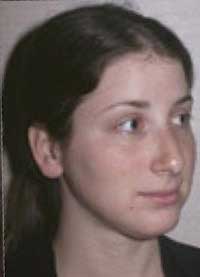
| 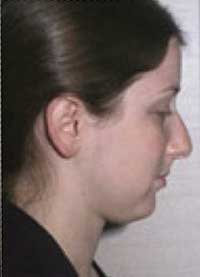 |
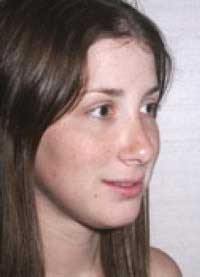 |
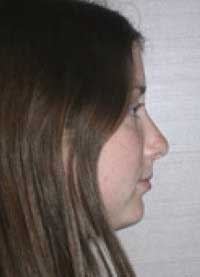 |
I first considered rhinoplasty when I was in Grade 9. I wasn’t obsessed about my nose or anything—I just wanted it to look smaller and more proportionate to my face.
My biggest problem was actually picking a date for the surgery due to my hectic schedule. I figured the best time would be between finishing high school and starting university, just before starting my summer job.
I was lucky because I didn’t have to shop around for a surgeon—Dr. Solomon and I hit it off immediately! He was warm, approachable and he answered all my questions in detail. When I explained that I didn’t want anything drastic, and how important it was to me to look natural, he understood my feelings exactly.
At our pre-op meeting, Dr. Solomon did a digital mock-up. We discussed what I wanted my nose to look like, and he made the changes right there onscreen. He then explained that all incisions would be made internally to prevent external scarring. My nose would be shortened and narrowed; the tip reduced slightly and the bump removed.
After the surgery at his clinic in Thornhill, Ont., I was a little groggy because of the anesthetic. But by day three, I was up and running around like usual! Ten days later, when the splint came off, my nose was still swollen but it looked great! (I couldn’t stop looking at it in the mirror!)
The swel l ing cont inued to go down, and my new nose has remained the same for several months. Was it worth it? Absolutely! I love my new nose, and, as for the actual surgery, I just had my wisdom teeth removed and, believe me, rhinoplasty was far easier.
Case No. 2: The Mother
Heather*, 34
Rhinoplasty performed by
Dr. Peter Adamson
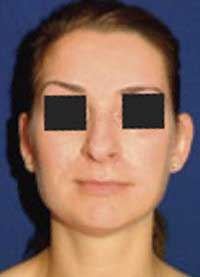 |
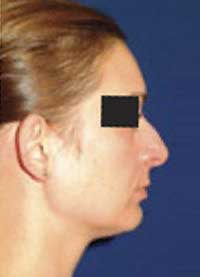 |
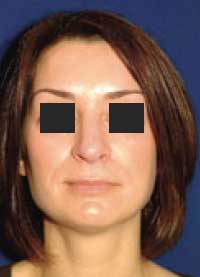 |
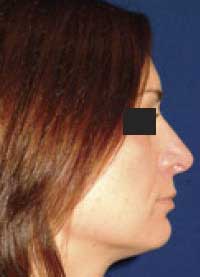 |
Even though I’d never been happy with my nose, I didn’t allow my feelings to hold me back socially or professionally. But when I had jaw surgery five years ago, the surgeon mentioned that rhinoplasty would improve the look of my nose. So, I decided to go for it!
I knew the best time to have surgery would be during my maternity leave. I waited till my baby was seven-monthsold and did a lot of research in the meantime. I quickly realized that I didn’t want a cookie-cutter nose. On some doctors’ websites, their patients’ noses looked like ski slopes after surgery, regardless of their ethnic backgrounds. Confused, I ended up phoning my maxilofacial surgeon for advice, and he recommended Torontobased Dr. Adamson.
As soon as I looked at the beforeand- after pictures on Dr. Adamson’s site, I knew he was the right surgeon for me. When I met with him, he was compassionate and caring as he inquired about my concerns. I told him I didn’t like my nose because it was too big and crooked, and my nostrils were too large. He soon discovered I also had a deviated septum.
Dr. Adamson outlined how he would correct this and also streamline my nose to harmonize with my other features. (He even told me he’d put extra cartilage in the tip, so my nose wouldn’t droop as I age!)
On the day of my rhinoplasty, I woke up feeling really excited, even though my husband was scared about me having surgery. But compared to my jaw operation, the rhinoplasty and septoplasty by Dr. Adamson were a breeze! I felt very cared for in his luxurious clinic.
My recovery went very well. Fortunately, my in-laws were around to help with the baby and our toddler. A month after surgery, the swelling had subsided to the point where people didn’t even notice. I was thrilled with the results—and I still am! But it’s not just about the way I look: Rhinoplasty was something I wanted to do for myself and, because I actually followed through with it, it’s made me a happier and more confident person.
* Some names have been changed to protect patient privacy.
In 2007, plastic surgeons performed rhinoplasties on 284,960 patients in the U.S., making it the thirdmost popular cosmetic surgery. Women accounted for 74% of the patients —American Society of Plastic Surgeons
Case No. 3: The Professional
Ashley*, 29
Rhinoplasty performed by
Dr. Gregory Antoniak
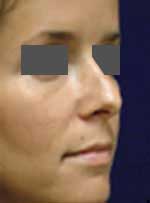 |
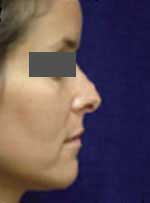 |
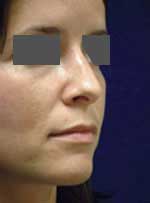 |
 |
I haven’t told anyone about my rhinoplasty, except my parents. People tell me I look great, but no one seems to realize I’ve had something done! It’s a subtle change—and that’s exactly what I wanted.
Although I’d never really liked my profile, I didn’t do anything about it until last year, because I wanted to be able to afford the surgery. Timing was important to me, as well. As it turned out, my biggest challenge was finding the right surgeon. Rhinoplasty seems especially risky, because you can’t hide any mistakes. By the time I went to see Dr. Antoniak, I’d already done lots of research and seen two other surgeons in the Ottawa area.
When I told Dr. Antoniak I avoided smiling because I thought it accentuated the size and shape of my nose, I didn’t feel judged— I felt supported and understood. In short: I knew I could trust Dr. Antoniak with my face.
Since I’m a teacher, it made sense to have surgery during summer vacation. At the Ottawa Hospital Riverside, Dr. Antoniak reduced the bump on my nose, refined the tip and made my nostrils smaller. He also did a septoplasty, so my breathing is much better now.
Post-surgery, I was able to walk and eat right away. I had some pain but nothing unbearable; although, I was a little shocked when the splint was taken off and my nose was still swollen. Fortunately, two weeks later I was good to go! (To be honest, I was really OK before that too—it just took me some time to get comfortable with my new nose.) I’m much happier today. I don’t feel the need to hide my profile when I’m smiling or laughing—such a relief !
If I had any advice to give someone considering the procedure, I’d say be patient and give your nose time to heal. Think of it this way: A small swollen nose is better than a large unswollen one, any day.
Elevate top 10 Nose-y Questions
Facial plastic surgeons Dr. Peter Adamson, Dr. Gregory Antoniak and Dr. Philip Solomon give you a heads-up on nose reshaping.
1. How can rhinoplasty help me?
Dr. Adamson: We can resculpt your nose, so it’s smaller, straighter, narrower and more symmetrical. The tip can be refined and nostrils reshaped, too. Bone may be trimmed and cartilage reduced, shifted and used to augment areas that need it.
2. Is it right for me?
Dr. Adamson: Your nose must be done growing, and it’s also important to be realistic—a rhinoplasty will give you more self-confidence, but it won’t solve long-standing emotional problems. Improvement, not necessarily perfection, is the most realistic goal.
3. Who pays for it?
Dr. Adamson: Provincial health plans will pay for rhinoplasty to repair damage caused by injury or birth defect. In Ontario, reconstructive surgery is covered within two years of the injury, or in the case of a birth defect, up to age 19 (a septoplasty is always covered). Otherwise, your rhinoplasty is considered cosmetic, and you will have to pay for it—but you can claim a portion as a tax credit.
4. What should I look for in a surgeon?
Dr. Adamson: Rhinoplasty is the most technically demanding facial surgery, so the more experienced your surgeon, the more likely you will get a harmonious result. Since you want your outer appearance to reflect your inner self, it’s also crucial to have a good rapport with your doctor.
5. What will my new nose look like?
Dr. Adamson: Up until a few years ago, I would sketch to help patients see their desired result. Ninety percent were happy with this approach, but the other 10 percent had problems visualizing. Using special software, I now make changes to a patient’s photo right onscreen during a consultation. It clarifies what a patient really wants, and I can use the photos in the operating room.
6. What should I do before surgery?
Dr. Adamson: At the pre-op meeting, I use Confirm, an interactive computer program, to ensure a patient is up to speed regarding surgery, recovery and possible outcomes. Surgeons also need to know about any medications, vitamins and supplements you’re taking. And we advise about what meds to stop taking before surgery, such as blood thinners and anti-inflammatories.
7. What can I expect on surgery day?
Dr. Adamson: Arr ive at the clinic about 90 minutes before the procedure to get prepped for surgery. The actual operation takes between an hour and 90 minutes. Patients can usually choose between conscious or unconscious sedation for a straightforward rhinoplasty. A general anesthetic is used for more complicated surgery, which might also include septoplasty or chin augmentation. Expect to spend another 90 minutes in observation. Have someone pick you up and look after you for the first two to four days.
8. Any tips for an easier, speedier recovery?
Dr. Adamson: Sleep with your head elevated with pillows, and cool compresses will reduce swelling. Keep your nose moist with a saline spray and a lubricant, such as Polysporin, for at least a week. Expect some nasal congestion, as well as swelling and bruising around eyes. Many patients don’t need their prescribed painkillers and are comfortable with overthe- counter medications. Avoid wearing glasses for a month, and don’t drive until the swelling around your eyes subsides.
9. When will I see results?
Dr. Adamson: The nasal splint and external sutures (if used) are removed within 10 days. After two weeks, most of the swelling settles, and you’ll look fine enough to resume your daily activities. You can engage in light exercise starting at three weeks, but avoid contact sports for at least two months, as minor injury might damage the results. By one month, you’ll be closer to your final look. Some swelling may continue for up to a year— usually in the tip if it’s been refined.
10. What is a “secondary rhinoplasty”?
Dr. Adamson: In up to 10 percent of my own rhinoplasty cases, revision surgery is needed to treat minor imperfections arising from the initial procedure. It can vary in complexity from minor surgical tweaks to complex surgery. These cases can be very challenging for the surgeon, but gratifying for the patient. Rhinoplasty is a complex operation, and patients must be aware that they might require more than one procedure for optimal results.
